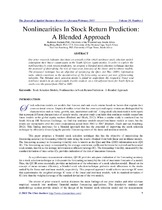| dc.contributor.author | Hodnett, Kathleen | |
| dc.contributor.author | Hsieh, Heng-Hsing | |
| dc.contributor.author | Van Rensberg, Paul | |
| dc.date.accessioned | 2017-06-06T09:17:32Z | |
| dc.date.available | 2017-06-06T09:17:32Z | |
| dc.date.issued | 2013 | |
| dc.identifier.citation | Hodnett, K. et al. (2013). Nonlinearities in stock return prediction: A Blended Approach. Journal of Applied Business Research, 29 (1): 7-22 | en_US |
| dc.identifier.issn | 0892-7626 | |
| dc.identifier.uri | http://hdl.handle.net/10566/2930 | |
| dc.description.abstract | Our prior research indicates that there are periods within which nonlinear stock selection models outperform their linear counterparts in the South African equity market. In order to explore the nonlinearities in stock return prediction, we propose a blended stock selection technique that has the potential of diversifying the risk of inaccurate forecasts of the linear and nonlinear models. The proposed technique has an objective of optimizing the Qian and Hua (2003) information ratio, which constitutes to the maximization of the forecasting accuracy per unit of forecasting volatility. The blended stock selection model is found to outperform the respective linear and nonlinear models in an out-of-sample fractile analysis on a risk-adjusted basis for South African stocks over the period from 2002 to 2007. | en_US |
| dc.language.iso | en | en_US |
| dc.publisher | The Clute Institute | en_US |
| dc.rights | Publisher retains copyright. Authors may archive the published version in their Institutional Repository. | |
| dc.subject | Stock selection models | en_US |
| dc.subject | Nonlinearities | en_US |
| dc.subject | Stock return | en_US |
| dc.subject | Forecasting accuracy | |
| dc.title | Nonlinearities in stock return prediction: A Blended Approach | en_US |
| dc.type | Article | en_US |
| dc.description.accreditation | Department of HE and Training approved list | |

